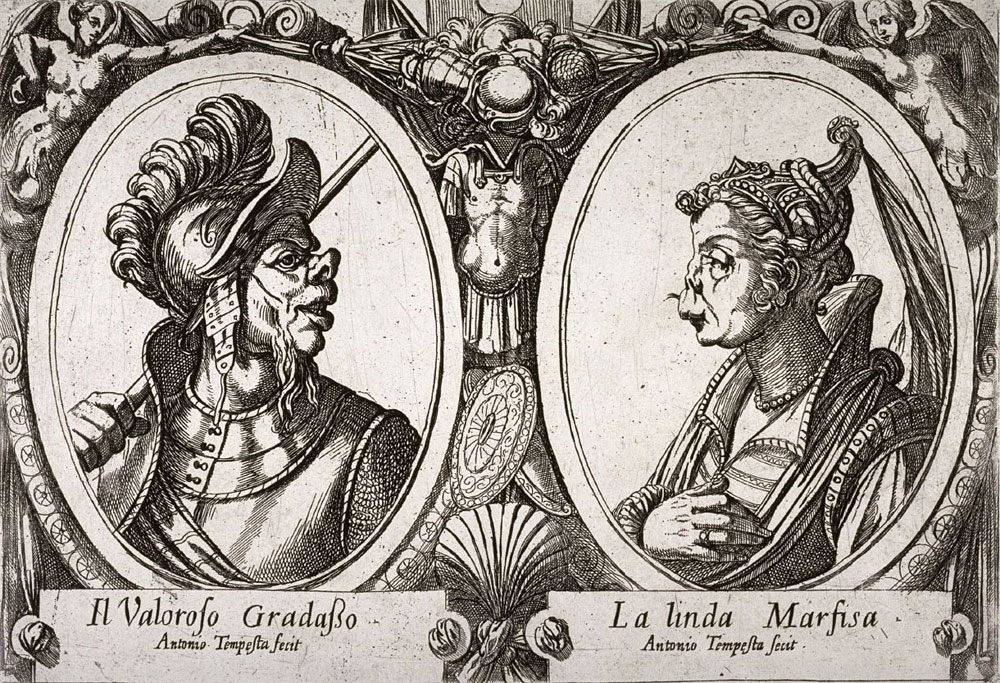'The War of the Romans Against the Batavians: The Burning of the Old Fortress'.
Antonio Tempesta, nicknamed "Il Tempestino", was a late 16th-century, early 17th-century Italian painter and engraver. Some of his etchings and engravings make use of illustrated sequential narratives, often with text underneath the images. His 'Life of St. Laurentius' (1599) tells the martyr's life in a series of miniature panels comparable to a comic book page. Together with Frans Hogenberg's picture stories about 'The Spanish Fury' (1576) and the 'Murder of Henry III' (1589), Otto Van Veen's 'De Bataafse Opstand' (1600-1613), Jacques Callot's 'Les Grandes Misères de la Guerre' ('Miseries of War', 1633), Francis Barlow's 'The Horrid Hellish Popish Plot' (1682) and various late-17th century comic strip-like political cartoons by Romeyn de Hooghe and early-18th century paintings by William Hogarth, they rank among the earliest sequential illustrated narratives which we can identify by author. In that regard Antonio Tempesta is the oldest Italian prototypical comic artist. His illustrations for the classic novel 'Orlando Furioso' also prove that Tempesta was a funny caricaturist.
Life and work
Antonio Tempesta was born in 1555 in Florence, Italy. In 1576 he entered the local Accademia delle Arti del Disegno, where he studied under Santi di Tito. Throughout his career he designed and painted many frescoes, paintings and engravings, mostly in Rome, Bagnaia, Caprarola and Tivoli. In 1580 he moved to Rome, where he would stay until his death in 1630. Several of his works were made under commissions of popes Gregorius XIII and Sixtus V. His depictions of animals, battles, hunts, parades and processions were quite popular at the time and widely copied. Iconic painters like Rembrandt van Rijn, Peter Paul Rubens, Diego Velázquez, Nicolas Poussin, Matthaüs Merian, Stefano della Bella and Giorgio di Chirico used them as an inspiration or reference for their own paintings. Jacques Callot was one of Tempesta's apprentices.
From: 'Orlando Furioso'.
Caricature
Tempesta continued the Italian tradition for caricaturing, introduced by Leonardo da Vinci, by illustrating Ludovico Ariosto's classic novel 'Orlando Furioso' around 1600. In the introduction he portrays the main characters Ruggiero, Bradamante, Rodomonte, Isabella, Gradasso, Marfisa, Angelica and Medoro in two-sequential panels which portray each couple looking at one another. Their features are grotesquely but hilariously exaggerated, proving that he had a talent for cartoony drawing which he unfortunately never explored again in his career.
Panel 40 from 'Ovid's Metamorphosis'.
Prototypical comics
In 1599 Tempesta illustrated the life of the saint Laurentius in a sequential narrative of 17 individual engravings. The central image shows Laurentius being roasted on a fire. His executioners carry fuel, while the prefect witnesses the event. Laurentius' martyrdom is emphasized by an angel flying towards him. Around this big image we see 16 miniature drawings, each depicting a chronological event from Laurentius' life with Italian-language descriptions written underneath them.
Like many of his contemporaries Tempesta made engravings inspired by events and mythologies from Antiquity. His 'Creation of the World' details the story of Adam and Eve in 12 chronological scenes, while 'The Crucifixion' depicts Jesus' conviction and death. 'The Labours of Hercules' visualizes Heracles' 12 tasks, while the artist also illustrated Ovid's 'Metamorphosis'. All these works are interesting because they are illustrated sequential narratives, sometimes with written explanations underneath the images. In the case of 'The Entry of Alexander into Babylon' and 'Batavorum cum Romanis Bellum' (1612) Tempesta visualizes two historical events - namely Alexander the Great's invasion of Mesopotamia and the Batavian uprising against Rome - in a chronological series of engravings with narration underneath each image. 'Batavorum cum Romanis Bellum' was inspired by a similar series of paintings about the Batavian rebellion by Dutch painter Otto van Veen. Yet Tempesta didn't just copy his work. Van Veen's work, while impressive, still feels a bit confusing at times because he only used 12 illustrations to tell his story. The lack of any dialogue or written descriptions makes certain scenes difficult to understand without preconceived knowledge. Tempesta's version is an improvement in that regard because he tells everything in 36 illustrations and with Dutch and Latin descriptions underneath each image. While many artists at the time had a tendency to shamelessly plagiarize other artists' works Tempesta used completely different compositions to tell the same key events.
Similar artists
Antonio Tempesta is the oldest known Italian prototypical artist whom we can identify by signature. Similar 16th- or 17th-century prototypical comic artists are the Germans Florian Abel, Hans Burgkmair the Elder, Lucas Cranach the Elder, Jeremias Gath, Hans Holbein the Elder, Hans Holbein the Younger, Bartholomäus Käppeler, Caspar Krebs, Georg Kress, Hans Rogel the Elder, Hans Rogel the Younger, Erhard Schön, Johann Schubert, Hans Schultes the Elder, Lucas Schultes and Elias Wellhöfer. In the Netherlands and Flanders we find Hieronymus Bosch, Pieter Bruegel the Elder, Frans Hogenberg, Johannes van den Aveele, Otto van Veen and Romeyn de Hooghe. A Czech prototypical artist is Der Prager Meister von 1609, a French artist Jacques Callot, while in England, Francis Barlow is an early example.






